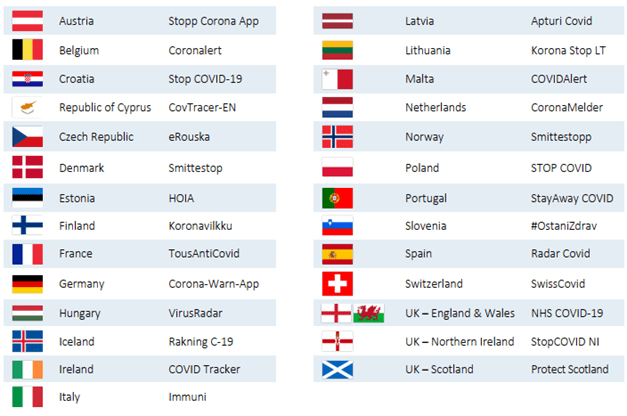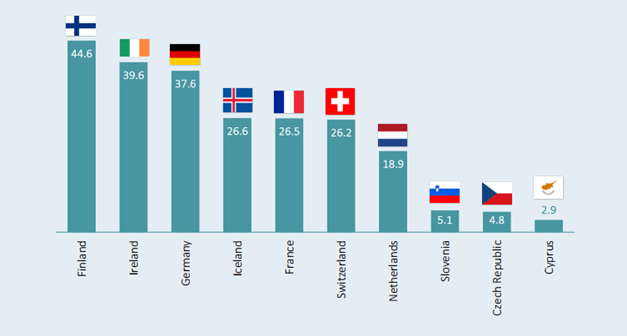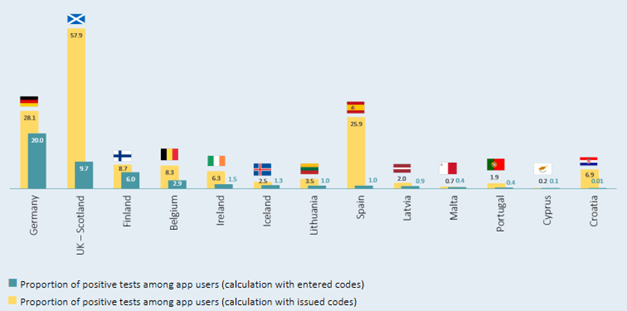To combat and exit the COVID-19 pandemic, countries worldwide have increasingly used digital technologies in support of public health measures for contact tracing. On behalf of the European Commission (EC), DG CONNECT, we conducted a study on 27 national digital contact tracing apps (CTAs) developed by European countries that were deployed shortly after the official declaration of the pandemic in March 2020.

Development
As tracing contacts across borders and across apps of Member States is essential for ensuring the EU’s freedom of movement principle, the EC collaborated with Member States to ensure a common approach to digital contact tracing, focusing on technical, legal, organisational, and epidemiological aspects. The eHealth Network (eHN) formed a dedicated working group of Member States experts covering technical, public health, organisational and legal matters, resulting in several guidelines and a Common EU Toolbox for Member States to guide the development and deployment of national solutions. This working group provided technical assistance, peer support, and learning from insights, practices, experiences and resulted in the reduction of implementation and operation costs of several national apps. Overall, 25 apps are open source and some re-used code or parts thereof.
The apps were developed mostly through public-private partnerships involving a wide range of stakeholders, including citizens, academic experts, and civil society organisations. National institutes or ministries functioned as commissioner, sponsor, regulator, and controller of the app while private companies were responsible for the technical lead, design, development, and support. In many cases new legal instruments were created or existing legislation adopted to enable these projects. During the development, the public was consulted on such topics as privacy, security, and trust. The public-private partnerships conducted data protection impact assessments and consulted with national data protection authorities during development and implementation. In terms of architecture 25 of 27 apps opted for a decentralised approach based on the Google and Apple Exposure Notification Framework, while two solutions chose a centralised solution. The proximity tracking itself is based on the Bluetooth low energy protocol.
During the pandemic, it was important to safeguard the right to free movement of EU citizens. As conventional contact tracing cannot account for cross-border infections, the EC set up the European Federation Gateway Service (EFGS) to allow different national apps to “talk” to each other, supporting Member States to have their own apps and features integrated within national processes while being able to warn citizens during travels. At the time, 19 countries were connected to the EFGS and until August 2022 a total of around 68 million keys have been uploaded to the EFGS, resulting in an estimated 8.6 million warnings to travelling citizens.
European Federation Gateway Service
- 19 Countries connected
- 68 million key uploaded
- 8.6 million travel warnings
As of August 2022, eight apps remain connected to the EFGS until the services will cease to operate when no more apps are connected. The European Commission and the European Centre for Disease Prevention and Control (ECDC), responsible for the EFGS daily operations since April 2022, are currently assessing the future of the digital contact tracing ecosystem at the European level.
Functionalities
The aim of digital contact tracing apps was and is to support public health measures by tracing infected people and warning their contact persons to break the chain of coronavirus infections, nationally and across border. The apps capture anonymised interactions between smartphones of individuals based on Bluetooth Low Energy enabled proximity tracing technology and subsequently issue warnings about close contacts with persons who have tested positive for the coronavirus.
Additional functionalities include:
- tracking symptoms
- vaccine and test certificates,
- vaccination statistics,
- additional information related to the epidemiological situation and related travel restrictions,
- check-in functions,
- self-isolation countdowns and the issuance of self-isolation certificates,
- EU Digital COVID Certificates,
- booking tests and receiving test results; connection to laboratories and test sites
- contacting relevant authorities via app
Adoption and use
The apps were adopted at a considerable scale in a voluntary manner and have been downloaded more than 206 million times between 2020 and July 2022, representing tens of millions of active users. Developers and Member states had created dedicated websites and promotional material together with awareness campaigns to boost uptake.
| 206+ million downloads | 56 million active users** |
| 13.4 million positive tests | 177+ million warning notifications* |
| Up to 70% of users with a positive COVID-19 test result entered their data to warn others | Rate of active users: 26-45%** |
| Up to 20% of all positive cases in a country covered by app | 0.8 – 19 exposure notifications per positive test entry |
* In seven countries: Finland, Ireland, Germany, Iceland, France, Switzerland, Netherlands
** In six countries: Finland, Ireland, Germany, Iceland, France, Switzerland
Evidence based on surveys made in some Member States shows the reasons for use or non-use of the apps vary:
Reasons for use of contact tracing apps:
- To support the Government
- Civic duty
- Concerns for own health and health of family/friends
- Trust in government/app developers
- To increase freedom
- To have knowledge about personal risk of infection
- Rapid warning and detection of risky contacts while preserving users’ privacy
- The app prevents the spread of the virus
Reasons for non-use of contact tracing apps:
- Lack of advantages/ lack of interest
- Data privacy/security concerns
- Not having a compatible smartphone
- Not able to download the app
- Fear of being geolocated
- Power consumption/Bluetooth activation
- Fear of greater surveillance
- No interest in being sent into quarantine
- Leading to unnecessary mental stress
- No knowledge about the app
- Lack of trust in government/app developers
- Lack of transparency
- Technological limitations
Over 13.4 million positive tests have been entered into the apps to warn other people at risk of infection and over 177 million warning notifications have been generated in the 27 apps. The percentage of active users per total population ranged between 26 and 45%, resulting in 56 million active users.

Up to 70% of app users with a positive COVID-19 test result entered their data to warn others which resulted in over 13.4 million positive tests and over 177 million warning notifications. Thus, between 0.8 and 19 exposure notifications were sent to potential contact persons.


Effectiveness
- Increased testing rates
- Higher detection rate of asymptomatic cases
- Reduced time to testing
Data indicates that notifications via tracing apps actively increase testing rates and reduce the time to testing in comparison to traditional contact tracing, leading to a higher number of positive findings: More than half of the persons who scheduled a test after receiving a notification from the Dutch app were not yet approached by the public health authorities at the time of booking a test. In addition, available evidence from some countries shows that that app users who got tested after receiving an app notification were found to be positive. In some cases, those users were asymptomatic and would not have tested themselves, exemplifying one of the main strengths of digital contact tracing when used to complement conventional tracing efforts.
There are several sequential steps involved in digital contact tracing: from exposure event to symptom onset, testing, receiving test result and activation code, uploading the activation code in the app, and receiving a notification via the app. Digital contact tracing can accelerate the last step of contact notification, by alerting potential contacts at risk as soon as the infected person receives the positive test result and enters the activation code into the app.
In comparison, manual contact tracing involves conducting interviews with the confirmed cases to identify close contacts with whom the confirmed person interacted 1-3 days before showing symptoms or being confirmed positive. It relies on accurately identifying all possible close contacts and on providing reliable contact data. This process lacks privacy and is also highly dependent on the capacity of manual contact tracing systems. Additionally, the possibility of a positive-tested person infecting others they might not be aware of exists.
Nevertheless, to fully understand the impact of the apps, more data should be collected in a standardised manner from the onset, and further actions can be explored, such as better aligning of digital apps with other public health processes.
Cost-effectiveness
Whether CTAs are cost-effective remains an open question. Unfortunately, early expectations reported in the media suggested a wide adoption of CTAs would stop the pandemic. While this hope did not materialise, some outlets concluded that CTAs are financially unsound. However, the need for a full socio-economic impact assessment remains including the need for a suitable cost-benefit analysis framework, with both quantifiable and non-quantifiable benefits such as lives saved due to averted cases. A tentative analysis of the social costs and benefits of the Dutch CoronaMelder suggests that the benefits are in balance with the costs, even if considering only the years of life saved by preventing deaths.
Outlook and recommendations
To begin with, we believe that the founding of the technical working group within eHN can be considered a success and should be applied to other health and care topics. The flexible, dynamic, and agile EU collaboration of Member States supported by the EC should be maintained as a good model for future use cases. Further, the common EU infrastructure and services such as the EFGS should be sustained as it demonstrates a unique example of a cross-border infrastructure that connects apps developed at MS level. In addition, the EU Toolbox should be updated and maintained as a valuable resource for pandemic responses for Member States. Overall, the integration and alignment of digital health apps with public health systems should be enhanced to achieve user-friendly experiences and increase the attractiveness of such apps.
We also believe that digital contact tracing has been a part of health systems’ resilience response to a new situation, developed at a very fast pace related to other innovations, and adopted at a considerable scale in a voluntary manner by a higher-than-expected amount of the population; an unprecedented large adoption of a new digital public health technology was observed in several countries. CTAs can achieve complementarity to conventional contact tracing and improve the timeliness of receiving results and reduce the burden on traditional processes and services.
The efforts related to digital contact tracing demonstrate the ability of Europe to agree on and deliver an innovative and emerging technology to millions of users in a privacy-preserving manner, enabled by effective coordination and collaboration between participating countries.
The existing potential can be leveraged, however, in terms of evaluating the effectiveness of the CTAs, an updated evaluation and monitoring framework with a new set of indicators is needed and data should be collected from the onset of development. Lastly, to achieve a meaningful cross-country comparison, there is a need for joint efforts and technical standardisation of the measured parameters.
Read the full study
Download Contact Tracing Study
Country factsheets
Contact
Alexandra Prodan
moc.a1766895062cirip1766895062me@na1766895062dorp.1766895062ardna1766895062xela1766895062
Strahil Birov
moc.a1766895062cirip1766895062me@vo1766895062rib.l1766895062ihart1766895062s1766895062